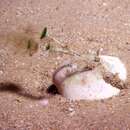fi
nimet breadcrumb-navigoinnissa


Acetabularia caliculus, the umbrella alga, is a species of green alga found in shallow temperate and tropical seas. It usually grows on pebbles, shells or pieces of rock, and is often found in seagrass meadows, on mudflats and coral reefs, in estuaries and growing on the submerged roots of mangroves. Each individual thallus consists of a single cell with a long stipe and a terminal cup-shaped or flattened disc.
The umbrella alga grows singly or in clusters. Each individual thallus consists of a single cell with a single nucleus.[2] There is a holdfast where the alga is attached to the substrate and a long, slender, calcified stipe or stalk. The thallus is emerald green and cup-shaped, or occasionally flattened, with twenty-two to thirty rays. The stipe is up to 7 centimetres (2.8 in) long and the disc up to 7 millimetres (0.28 in) in diameter. In immature specimens, the stipe has a complex structure of short branches but by the time the alga reaches maturity, only the scars of these remain.[2]
The umbrella alga has a widespread distribution in shallow temperate and tropical seas, occurring on the eastern coast of the United States from North Carolina southwards, the Caribbean Sea and Gulf of Mexico and on the eastern side of the Atlantic and the Mediterranean Sea. It is also found in the Indo-Pacific and the seas around Australia and New Zealand.[3] It most often grows on pebbles, shells or pieces of rock at depths down to 20 metres (66 ft). It is often found in seagrass meadows, on mudflats and coral reefs, in estuaries and growing on the submerged roots of mangroves.[2]
The green colour of the umbrella alga is caused by the presence within the cell of chlorophyll and the plant's energy needs are supplied by photosynthesis. If the plant is broken in two pieces, each is able to survive and regenerate new parts, even the one that lacks a nucleus, although the anucleated fragment will die after a few weeks.[2] The umbrella alga has the ability to remove mercury from sea water and concentrate the metal in its tissues in polypeptides.[4]
Sexual reproduction takes place after tiny cyst-like gametangia develop on the rays of the disc. These have tiny caps which open to release gametes into the sea. Each plant produces only one type of gamete, and two gametes of different types unite to form a zygote. This sinks to the bottom of the sea and begins to produce a new stipe which later develops several whorls of short hairs and eventually a new disc. The life cycle takes about six months to complete.[2]
Acetabularia caliculus, the umbrella alga, is a species of green alga found in shallow temperate and tropical seas. It usually grows on pebbles, shells or pieces of rock, and is often found in seagrass meadows, on mudflats and coral reefs, in estuaries and growing on the submerged roots of mangroves. Each individual thallus consists of a single cell with a long stipe and a terminal cup-shaped or flattened disc.
Acetabularia caliculus est une espèce d’algue verte de la famille des Polyphysaceae. Elle se rencontre dans les eaux tropicales et tempérées du globe.
Par leur physionomie caractéristique, les algues vertes du genre Acetabularia sont communément nommées les algues ombrelles[2].
Acetabularia caliculus croit indifféremment seule ou en groupe dont chaque algue est constituée d'une unique grande cellule avec un seul noyau.
L'algue est fixée au substrat par un crampon d'où par une longue et fine tige calcifiée terminée par un disque unique qui représente le corps de l'algue. Ce disque est en général en forme de coupe mais peut être parfois plat, sa teinte est vert vif et il est composé de 22 à 30 rayons[2].
La taille maximale que peut atteindre cette algue est de 7 cm pour un diamètre de disque de l'ordre de 7 mm[3].
Acetabularia caliculus possède une large distribution et est présente dans toutes les mers tropicales et tempérées soit le long des côtes de l'Océan Atlantique occidental de la Caroline du Nord (États-Unis) au Brésil en passant par le Golfe du Mexique ainsi que la Mer des Caraïbes; en Mer Méditerranée, ainsi que le long des côtes de la péninsule ibérique et des côtes africaines jusqu'en Namibie; dans tout l'Océan Indien et Pacifique, Mer Rouge incluse[2].
Elle affectionne les herbiers, les zones rocheuses, les récifs coralliens, les estuaires, les mangroves jusqu'à une profondeur de 20 m[2].
La teinte verte de l'ombrelle est due à la présence de chlorophylle dans la cellule dont les besoins énergétiques sont donc satisfaits par la photosynthèse[2].
Si l'algue est divisée en deux parties, chacune de ces dernières sont capables de se régénérer et de donner deux algues distinctes même la partie qui ne possède pas le noyau[2].
Les algues ombrelle ont la capacité de capter le mercure présent dans l'eau de mer et de le concentrer dans ses tissus en polypeptides[4].
Acetabularia caliculus est une espèce d’algue verte de la famille des Polyphysaceae. Elle se rencontre dans les eaux tropicales et tempérées du globe.